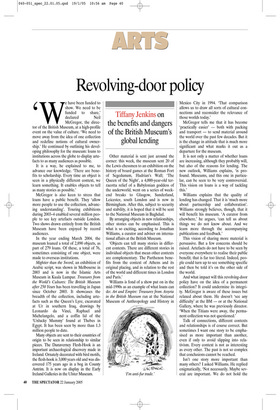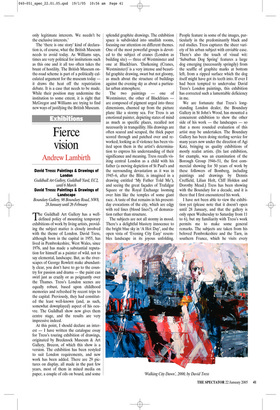Revolving-door policy
Tiffany Jenkins on the benefits and dangers of the British Museum’s global lending
‘We have been funded to show. We need to be funded to share,’ declared Neil McGregor, the director of the British Museum, at a high-profile event on the value of culture. ‘We need to move away from the idea of one collection and redefine notions of cultural ownership.’ He continued by outlining his developing philosophy for the museum: loans to institutions across the globe to display artefacts to as many audiences as possible.
It is a way, he explained to me, to advance our knowledge. ‘There are benefits to scholarship. Every time an object is seen in a physically different context, we learn something. It enables objects to tell as many stories as possible.’ McGregor is also keen to stress that loans have a public benefit. They ‘allow more people to use the collection, advancing understanding’. Touring exhibitions during 2003–4 enabled several million people to see key artefacts outside London. Two shows drawn entirely from the British Museum have been enjoyed by record audiences.
In the year ending March 2004, the museum loaned a total of 2,890 objects, as part of 279 loans. Of these, a total of 76, sometimes consisting of one object, were made to overseas institutions.
Mightier than the Sword, an exhibition of Arabic script, was shown in Melbourne in 2003 and is now in the Islamic Arts Museum in Kuala Lumpur. Treasures from the World’s Cultures: The British Museum after 250 Years has been travelling in Japan since October 2003. It showcases the breadth of the collection, including artefacts such as the Queen’s Lyre, excavated at Ur in southern Iraq, drawings by Leonardo da Vinci, Raphael and Michelangelo, and a coffin lid of the ‘Unlucky Mummy’ found at Thebes in Egypt. It has been seen by more than 1.3 million people to date.
Many objects are sent to their countries of origin to be seen in relationship to similar pieces. The Dunaverney Flesh-Hook is an important archaeological discovery made in Ireland. Ornately decorated with bird motifs, the flesh-hook is 3,000 years old and was discovered 175 years ago in a bog in County Antrim. It is now on display in the Early Ireland Galleries in the Ulster Museum. Other material is sent just around the corner: this week, the museum sent 20 of the Lewis chessmen to an exhibition on the history of board games at the Roman Fort of Segedunum, Hadrian’s Wall; ‘The Queen of the Night’, a 4,000-year-old terracotta relief of a Babylonian goddess of the underworld, went on a series of weekend breaks to Glasgow, Sunderland, Leicester, south London and is now in Birmingham. After this, subject to security and stability, it is hoped that it will be sent to the National Museum in Baghdad.
By arranging objects in new relationships, other stories can be emphasised. This is what is so exciting, according to Jonathan Williams, a curator and adviser on international affairs at the British Museum.
‘Objects can tell many stories in different contexts. There are different stories in individual objects that mean other contexts are complementary. The Parthenon benefits from the context of Athens and its original placing, and in relation to the rest of the world and different times in London and Paris.’ Williams is fond of a show put on in the mid-1990s as an example of what loans can do: Art and Empire: Treasures from Assyria in the British Museum ran at the National Museum of Anthropology and History in Mexico City in 1994. ‘That comparison allows us to draw all sorts of cultural connections and reconsider the relevance of those worlds today.’ McGregor tells me that it has become ‘practically easier’ — both with packing and transport — to send material around the world over the past few decades. But it is the change in attitude that is much more significant and what marks it out as a departure for the museum.
It is not only a matter of whether loans are increasing, although they probably will, but also of the reasons for lending. The new outlook, Williams explains, ‘is profound. Museums, and this one in particular, can be seen to be very controversial. This vision on loans is a way of tackling this.’ Williams explains that the quality of lending has changed. That it is ‘much more about partnership and collaboration’. Williams strongly believes, though, that it will benefit his museum. ‘A curator from elsewhere,’ he argues, ‘can tell us about things we do not know about. And we learn more through the accompanying publications and feedback.’ This vision of sharing more material is persuasive. But a few concerns should be raised. Artefacts do not have to be seen by everyone everywhere to realise their public benefit; that is far too literal. Indeed, people could turn up to see something specific and then be told it’s on the other side of the world.
And what impact will this revolving-door policy have on the idea of a permanent collection? It could undermine its integrity. McGregor is aware of these issues but relaxed about them. He doesn’t ‘see any difficulty’ at the BM — or at the National Gallery, where he was previously director. ‘When the Titians were away, the permanent collection was not questioned.’ Talk of connections, different contexts and relationships is of course correct. But sometimes I want one story to be emphasised as more important than another, even if only to avoid slipping into relativism. Every context is not as interesting as every other. The past is not so complex that conclusions cannot be reached.
Isn’t one story more important than many others? I asked Williams. He replied enigmatically, ‘Not necessarily. Maybe several are important. We do not hold the only legitimate interests. We needn’t be the exclusive interests.’ The ‘there is one story’ kind of declaration is, of course, what the British Museum needs to avoid today. As Williams says, times are very political for institutions such as this one and it all too often takes the brunt of hostility. The British Museum onthe-road scheme is part of a politically calculated argument for the museum today it draws the heat off the repatriation debate. It is a case that needs to be made. While their position may undermine the institution to some extent, it is right that McGregor and Williams are trying to find new ways of justifying the British Museum.














































 Previous page
Previous page